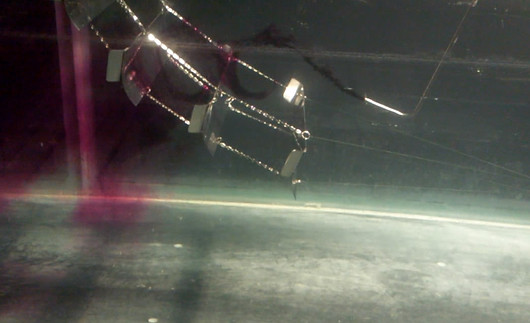Scale Model at Deltares
The first wave testing was done at Deltares with Cilia Swinkels. The concept and model were improved, the high resistance to waves and the features of moving in orbital motion along with the waves were proven as well as the great amount of work that could be generated. In conditions representing 12m ocean waves and higher, the model continued to generate the nominal power output with no overload forces observed.
Development
Scale Model at TUD
First tests with the unique blade system were done at TUD with Prof Uijttewaal. First positive results were acknowledged as resistance to an open flow and generated work were higher than what could be expected from a single floating body in a stream. It was found that deflecting the angle of attack from a current onto a blade system that moves in the same direction as the current, will increase resistance and work considerably. Stability of a floater and blades perpendicular to the main current were also proven as well as the ability to steer the device in different directions by manipulating the blades.
Open Water Testing
The concept and model were further improved and tested in open water. This was the first time a Slow Mill model was actually autonomously generating electricity. The concept of plug and play was introduced to avoid costly installation, operation and maintenance procedures at sea. Measurements showed high percentages of wave energy generated as well as high percentages of wave reduction in the wake of the unit. Energy taken out of the waves has a damping effect in the wake that helps cooling seawater temperatures and provides shelter for other users.
Open Sea trials
The concept and model were further improved and tested in open sea at Scheveningen. Important data was found as during 2 years of testing no leaks were observed. A smart way of protecting steel parts against corrosion was tested with good results. Highly valuable data was gained to optimise energy generating capabilities; hyper resonance increases efficiency over 50% by following waves of various frequencies at a fraction of their phase. Installation and maintenance procedures at sea were improved to minimize expensive offshore operations. Long lasting materials such as marine quality concrete and fiberglass composites were introduced to decrease fatigue and cost while greatly extending the technical lifetime. More than 7 supply companies were incorporated to come to an advanced state of the art prototype that would work economically and efficient in the North Sea.
Future Projects

A full scale 20 ton model is being prepared. It will be ca. 20m long, 12m deep, 3m diameter and generate about 300-400 kW in stormy North Sea conditions. As soon as the prototype performs well and small series can be build, a rough cost estimate would set the price around 1M/MW. Later on, when economics of scale and learning curve set in, prices will be more favorable. The first Slow Mill wave farm will be build near a wind farm to obtain great synergy advantages and reduce cost even further. (see presentation below)
Future projects
2010
2010
2012
2014
2016



